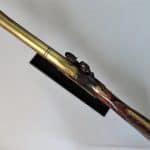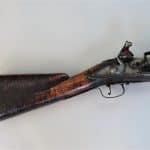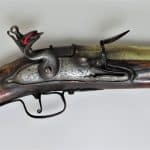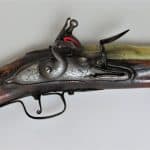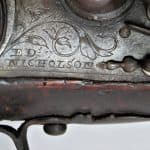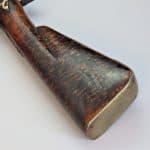
A Blunderbuss by Edward Nicholson of London circa 1685
To enquire about this itemplease click here
Price: £5,450
Ref: AA.076.22
Item Description
A scarce late 17th century English blunderbuss by Edward Nicholson of London dating to circa 1685. The blunderbuss is of fine quality mounted with an imposing brass barrel, attractive rounded lock and “Tiger-Stripe” decorated full stock.
Following the Restoration of the monarchy in England in 1660, firearms including blunderbusses, increased in popularity in civilian life and in the Services, particularly with the Navy. A manuscript dated 1684 shows that ships were entitled to a number of blunderbusses represented as a proportion of the number of cannon employed on board.
Edward Nicholson was part of a family of gunmakers by that name that worked in London. He also had a gunmaking son called Edward. This blunderbuss is a fine example of the work of Edward Snr. He was part of a movement amongst gunmakers that helped develop London gunmaking to a hitherto unseen level of quality towards the end of the 17th century as the city left behind the austerity of the Civil War years and prospered as an international trading centre. This wave of innovation spread to other crafts and arts in the city.
Nicholson served his apprenticeship with Robert Silke and Michael Richardson from 1668, and was made free of the Gunmaker’s Company in 1675. He was elected Assistant to the Company in 1691 and Master in 1697 and recorded as Gunmaker based in the Minories and separately as contractor to the Ordnance from 1687 to 1711, to the Hudson’s Bay Company from 1687 to 1712 and to the East India Company in 1700. He died in 1712.
The blunderbuss is mounted with a heavy brass barrel of octagonal section at the breech becoming sixteen sided until a raised ribbed band about a third of the way along. Afterwards the barrel is of rounded section, narrows towards its middle then gently flares towards its muzzle. The “V” shaped rear sight is cut through a raised ribbed ramp at the breech. The square ended tang is of iron.
The off-side octagonal flat surface of the barrel is clearly stamped with the London Gun Company View and Proof marks. Above these, the mark of a sunburst with a face inside and the letters “E N” below are stamped. This is the mark of Edward Nicholson Snr registered with the London Gun Company.
The border engraved rounded lock has a nippled tail bedded into the moulded stock. The rounded cock, the area behind it, and in front, are attractively engraved with strawberry leaf scrolls. The maker’s mark E D NICHOLSON is stamped into the lower part of the lock plate in front of the cock. The lock is secured to the stock by large transverse screws, two of which, with dome heads, are visible on the reverse side, which also hold in place a domed brass serpentine side plate.
The iron trigger terminates in a backward scroll within the iron guard which is attached to the stock by a screw to the front, and a pin to the rear, near the leaf-shaped finials. Behind the trigger, the head of the barrel tang screw is visible, the tip of which passes through the stock and penetrates the iron tang above to secure the barrel to the stock at the breech. This is the “old” form of engaging the tang. Towards 1700 the method changed to reverse the direction and apply the screw head from above the tang rather than from below.
Behind the tang a vacant brass escutcheon is pinned to the wrist. The brass butt plate, with tail on top, is secured to the butt with iron tacks fixed flush to the surface. The wooden tapered ramrod fixes into a bored aperture without tail pipe and is supported by a single banded brass tube and ramrod groove in the fore end.
The full Elm stock is nicely shaped and was finished by charring and polishing to enhance the appearance of the wood to create a “Tiger-Stripe” effect. This attractive feature is evident all over the stock, although typically worn on the wrist, which is the area that receives most abrasive contact with the user’s hands and is most subject to wear. This stock finishing technique was applied to the stocks of the best of Nicholson’s guns and those of his contemporaries.
The blunderbuss is in good condition overall. The iron parts are a russet colour consistent with the age of the blunderbuss. The wooden stock is a nice dark colour with some minor dents and bruising in places and minor evidence of old worm. The tang is screwed into an apron moulded around it on the stock which is slightly chipped at the rear.
The barrel is just over 16 and one eighth of an inch (41.5 cm) long, and the overall length of the blunderbuss measured extremity to extremity is just over 30.5 inches (77.5 cm).
References: D R Baxter, “Blunderbusses”, Arms and Armour Press, 1970 and Howard L Blackmore, “A Dictionary of London Gunmakers”, 1350-1850, Phaidon, Christie’s Limited, 1986, page 78.







